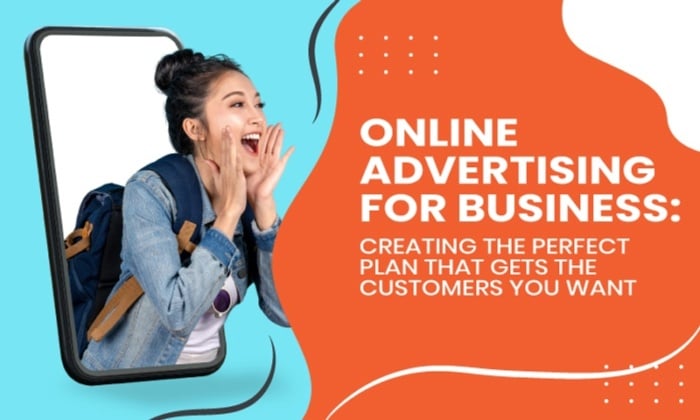
The internet has transformed the advertising industry. Traditionally hard-to-measure channels like TV, billboards, and sponsorships are being pushed to the wayside by cheap, trackable online advertising channels like social media ads, display, and paid search ads.
This shift is democratizing the industry. Even the smallest brands can compete on the same platform as multinationals if they have the right knowledge, ad creatives, and targeting. If you want to grow your business, online advertising should be the first place you start.
I’ll show you how you can do just that in this guide. You’ll learn why online advertising is so beneficial, the best online advertising channels to use and how to create an online advertising campaign from scratch.
What Is Online Advertising?
Online advertising is a hugely popular strategy, with almost two of every three small businesses using it to win new customers. Spending won’t decrease any time soon, either. Global online advertising spend is predicted to hit $646 billion by 2024, up from $378.16 billion in 2020.

Online advertising is a form of paid-for marketing that leverages internet-based channels to promote products and services. There are plenty of online advertising channels to choose from, including search engines like Google or Bing, social media platforms, and display ads, banner ads, and native ads.
Unlike traditional advertising mediums, the cost of online advertising is low. Small businesses can generate hundreds of new customers for just a couple hundred bucks a month. Online advertising is more measurable, too. Every channel can be tracked, measured, and optimized, so marketers squeeze as much ROI from their campaigns as possible.
Such are the benefits of online advertising, companies are increasingly dedicating more and more of their budget to digital channels.
As you can see in this infographic from Visual Capitalist, there have been sharp falls in newspaper and TV advertising spending, while search, social media, online video, and e-commerce spending has increased dramatically since the early 2000s.
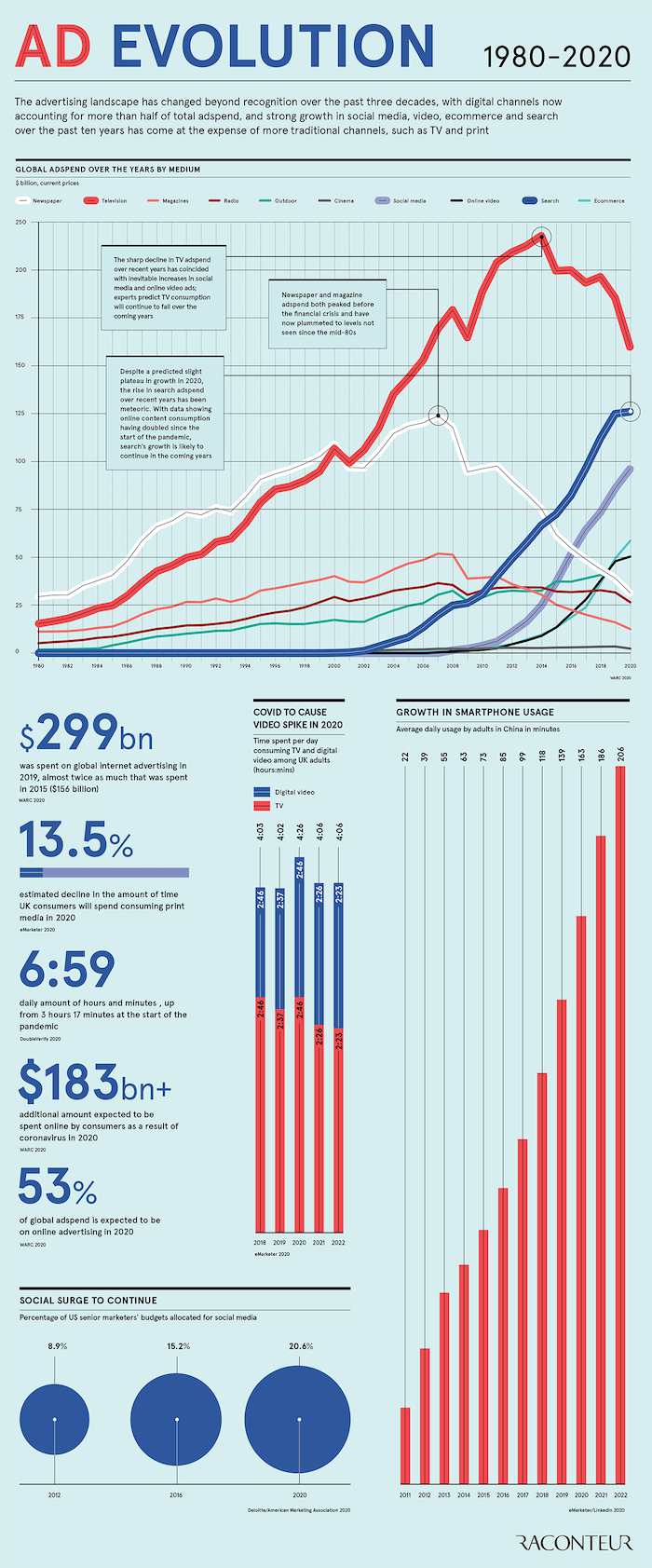
Why Your Business Should Advertise Online
However big your business, online advertising is one of the best ways to build a brand, win new customers, and grow revenue. It has many advantages over traditional forms of advertising and other forms of online marketing, but there are four big benefits I want to highlight.
Immediate Results
When you advertise online, you don’t have to wait months, weeks, or even days to get rewarded for your efforts. Sales can happen as soon as your ads go live.
This is unlike virtually any other form of marketing—traditional or otherwise. With SEO, for instance, it takes an average of about three months for a page to rank well on Google. Social media accounts tend to grow between 9.4 percent and 16 percent every six months.
The speed at which you see results doesn’t just help you win customers and drive revenue faster, it also helps you optimize campaigns quicker. Because you get data so fast, however, you’re able to optimize your campaigns to maximize ROI much faster. What takes six months or more with SEO, takes just three months with paid ads.
This is vital because optimizing PPC campaigns can double your ROI or more. Easton Sports, for example, doubled its ROI from 400 percent to 900 percent by working with e-commerce marketing agency The Good.
Better Targeting
Forget broad, mass-market ads that aim to please everyone. Online advertising lets you drill down into your target market and know with confidence that every dollar of your budget is being spent on them. That’s the kind of targeting traditional advertising can never compete with.
Most online advertising channels offer granular targeting, allowing you to focus your efforts on a small segment of their audience. Facebook lets you customize your target audience by dozens of criteria, including:
- location
- age
- gender
- education
- job
- interests
- behavior
- connections
As a result, you don’t have to worry about wasting your advertising budget on people who aren’t interested in your product. If you have strong buyer personas, you can target them with ease. Even if you don’t have buyer personas, granular targeting makes it easy to identify profitable segments of a large audience.
Better still, online advertising allows you to reach millions of people every day. Facebook has almost three billion monthly active users. Google processes around 63,000 queries every second. No other advertising medium lets your average joe business reach audiences of this size.
Low Costs
You won’t be forking over millions in advertising fees to reach targeted audiences. Unlike traditional advertising—where it can cost over $100,000 to run a 30-second TV advert—the cost of online advertising is incredibly low.
It costs, on average, just $3 to $10 to reach 1000 people with online advertising, compared to $22 to reach 1000 people using traditional methods. While your mom and pop retailer can’t hope to afford a TV advert, they can run a successful online advertising campaign on Facebook, Google, or any other channel.
You can limit the cost of your online advertising, too. The vast majority of online ad platforms will let you set a limit on your total and budgets, so you don’t blow everything at once.
Loads of Data
The worst thing about traditional forms of advertising like print, TV, or radio is that it’s tough to work out how well your campaign performed. That’s not the case with online advertising, where most channels show you exactly how well your ads performed.
Typically, online advertising channels will show how many people saw and clicked your ad, how many sales your ad resulted in, and many, many more metrics.
This data is gold. First, it allows you to measure ROI to see whether your online advertising is delivering a return.
Second, you can use that data to optimize your campaigns and make them even more profitable. With it, you can understand why your ad performed well or poorly and what you can change to improve your ROI in the future.
Types of Online Advertising for Businesses
Below are the main types of online advertising you need to know
1. Paid Search
Paid search is one of the most important online advertising channels. The vast majority of all online interactions start with a search engine—which makes it one of the best places to target potential customers.
Google is the dominant force in paid search advertising, which is unsurprising given it currently enjoys an 85 percent global market share. Other search engines like Bing and DuckDuckGo also offer paid ad solutions.
Paid ads come in two models: pay per click and CPM. With pay per click, brands pay every time someone clicks on their ads. With CPM, brands pay a set cost per thousand views.
They are usually positioned at the top of search result pages, as you can see below. They may also feature at the bottom of result pages and in separate tabs, like the Shopping tab.
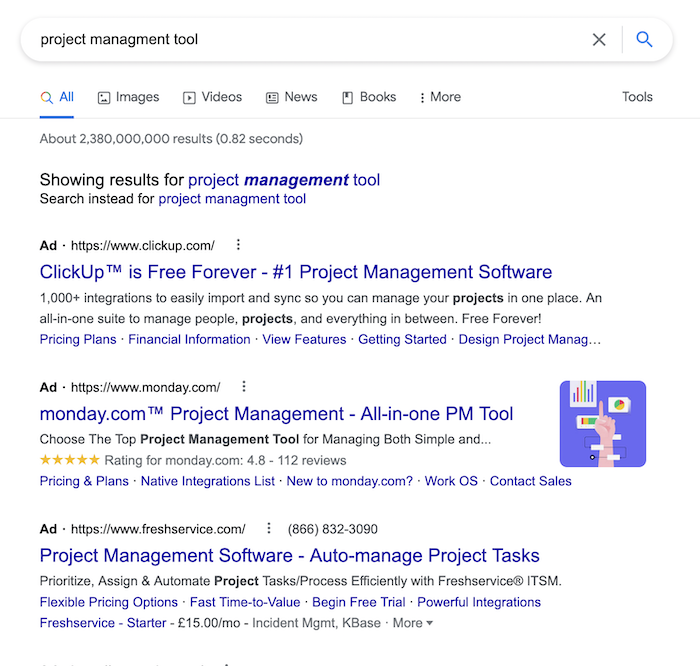
Paid search offers some of the best targeting available to online advertisers. Brands can target specific keywords, destinations, devices, and more. This allows them to create highly relevant ads that can return an average ROAS of 200 percent.
That comes at a cost, however. Paid search ads are some of the most expensive you can buy. The average CPC of Google Ads is between $1 and $2. Averages can rise much higher in some industries like law—where the average CPC is more than $6.
Pros:
- huge reach
- fantastic targeting
- immediate results
- high intent traffic
Cons:
- can be expensive
- not visual ads
- highly competitive
2. Social Media Advertising
Social media advertising is huge. It is the second biggest digital advertising market with revenues of $153.7 billion in 2021. That’s expected to grow to $252.6 billion in 2026.
Consumers are obsessed with social media, too. Over half of the world’s population use some form of social media and the average person uses it for 2 hours and 27 minutes every day.
Every major social media platform has an advertising offering, including:
Ad formats vary depending on the platform, but the vast majority will be a form of in-feed ad. Facebook, for example, has four main ad formats.
The cost of social media ads will also vary depending on the platform. As you can see in this table by WebFX, LinkedIn and Instagram are two of the most expensive platforms with average CPCs north of $3. Facebook and Twitter tend to be the cheapest.
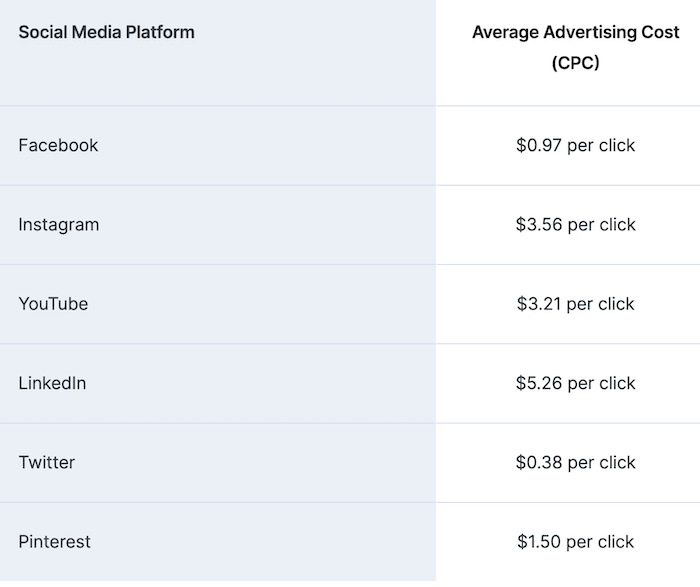
Pros:
- insane targeting
- wide audience reach
- effective for brand awareness and sales
- some channels have low costs
Cons:
- costs can be very high on popular channels
- a lot of competition
- can be hard to find the right platform
- Apple tracking updates may cause issues
3. Native Ads
Native ads don’t feel like they’re ads at all. Brands partner with publishers to create sponsored content that provides a lot of value to the reader while subtly promoting your business. The content is published on the partner’s site and distributed as normal. The idea is that users read the content and get value from it without feeling like they’re being sold to. It’s a win-win.
Here’s an example of a typical native ad on Fast Company. Note the small “paid content” disclaimer in the top right-hand corner.
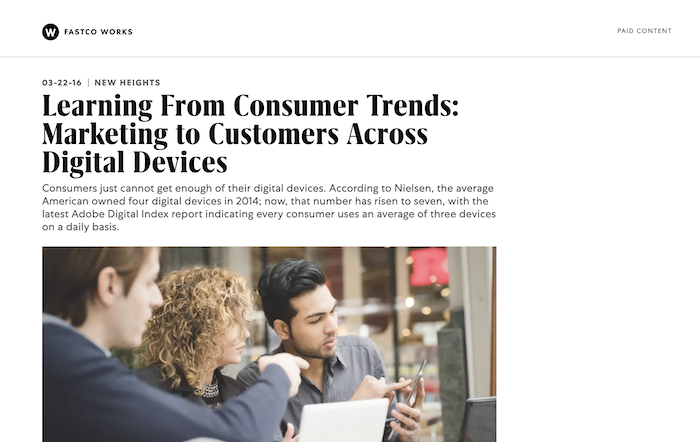
Native ads can be very effective.
It’s been shown the softer touch of native ads can result in five to ten times higher CTRs than direct response ads. Native ads can be expensive, however. Major publications charge as much as $200,000 to get featured.
The vast majority of major publishers will offer some form of sponsored content or native ad package, making it easy for your brand to get featured in dozens of high-quality publications.
Pros:
- build trust
- appear authentic
Cons:
- high effort required
- typically smaller returns on investment
4. Display Ads
Display advertising is one of the most common forms of online advertising. In fact, it’s probably the one that came to mind when you saw the title of this article. Display ads come in many forms, including banner ads, in-content ads, side-bar ads, and popups.
Below you can see an example of a banner display ad on Digiday.

There are multiple ad platforms that brands can work with to run these ads. Popular platforms include:
- Google Display Network
- Facebook Network Ads
- Taboola
- Leadbolt
Display ads are one of the most cost-effective forms of online advertising, costing as little as $0.50 per click. There’s a trade-off, however, as display ads typically have some of the lowest CTRs of any online ad.
Pros:
- cost-effective
- widely available
- great for brand awareness
Cons:
- low CTRs
- tend to be ignored or blocked
- linked with poor UX
5. Retargeting Ads
Retargeting ads are much more effective than standard display ads.
That’s because consumers rarely make a purchase the first time they land on your website. When you show them the same products that previously caught their eye, they’ll be more likely to eventually make a purchase.
That’s where retargeting ads come in. This is a form of display ad that only targets people who have landed on your website and left without making a purchase.
Retargeting ads can appear on any website that shows display ads, as well as Facebook and Google. The cost of retargeting ads will depend on where they are displayed. The average cost of retargeting ads on Google, for example, is $0.66 to $1.23 per click. Display retargeting ads will be much cheaper.
Pros:
- only target people who have shown an interest in your brand
- higher CTR than display ads
Cons:
- can feel intrusive
- harder to run after privacy updates
6. Affiliate Ads
Affiliate advertising is where a brand partners with a third-party (usually a publisher or influencer) to promote its products or services. Rather than an upfront payment, third-party gets paid a commission every time they refer a customer to the brand.
Affiliate advertising is a rapidly growing market and is expected to be worth $8.2 billion in the U.S. in 2022.
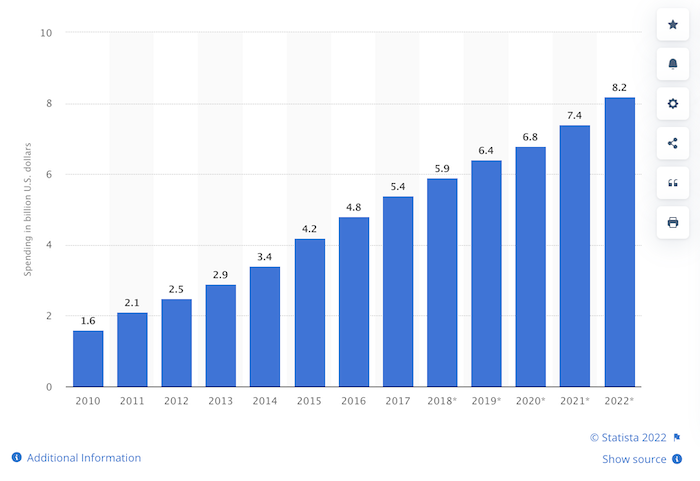
The cost of affiliate marketing can vary dramatically depending on the industry you operate in and the third parties you partner with. Commission rates vary between $3 and $200 and can be as low as 1 percent per sale or as high as 60 percent.
Pros:
- only pay when you make a sale
- easy to get started
- lots of third parties and publishers
Cons:
- can be required to give away a large percentage as commission
- can be time-consuming to stay on top of affiliates.
7. Video Ads
Video ads are an increasingly popular form of video-based advertising. The most common form of video ads are YouTube ads, but other video platforms like Vimeo host ads, too.
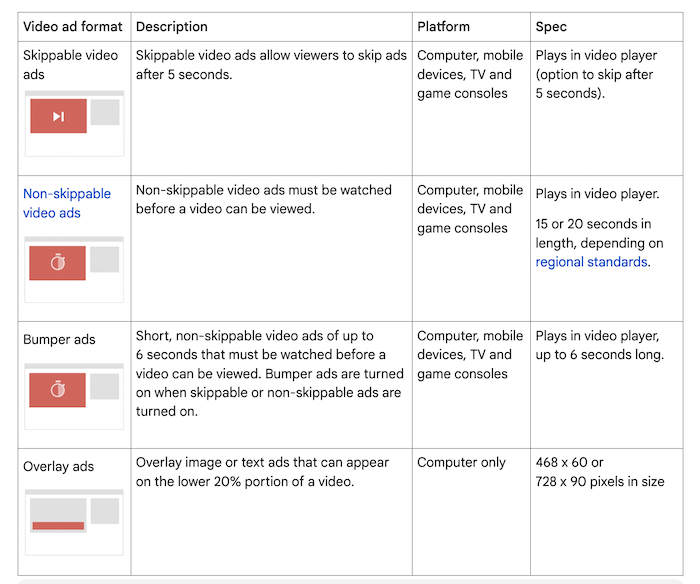
The potential reach of video ads is huge. On YouTube alone, consumers watch more than one billion hours of videos every day. YouTube also ranks second in monthly user numbers for social network platforms and is the world’s second-largest search engine.
They are cost-effective, too. YouTube ads have an average cost-per-view between $0.01 and $0.03. It costs around $2000 to reach 100,000 users.
Pros:
- ads personalized to video topic
- multiple ad variants
- detailed targeting options
- broad target audience
Cons:
- must create a video ad
- some ads can be skipped
How to Create an Online Advertising Strategy for Your Business
The steps to create an online advertising strategy will be broadly similar regardless of your business, product, or service. You start by setting goals, defining your target audience, and assigning a budget. Next, you pick a channel and create ads. Then it’s simply a case of launching and optimizing as necessary.
Step 1: Set Goals
You should always set goals for your online advertising campaign. Having a clear idea of what you want to achieve with your strategy and how you measure those goals will keep you on track, increasing the likelihood of success.
One study found that 76 percent of people who wrote goals down, made a list of actions, and ran weekly progress reports achieved their goals.
Making more sales is a typical online advertising strategy goal, but it’s not the only one. Others include:
- increasing brand awareness
- getting more subscribers
- growing your social media following
Whatever your goal, make sure it follows the SMART (specific, measurable, achievable, relevant, time-bound) framework.
Instead of saying you want to acquire new customers with your Google Ads campaign, state that you want to acquire 1000 customers in one month by spending $5,000 on ads.
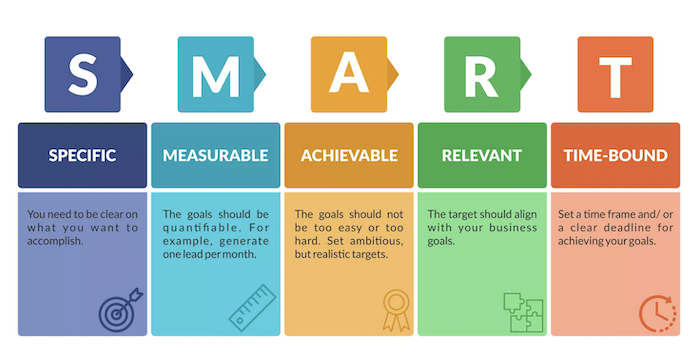
Step 2: Find Your Target Audience
With a goal in place, it’s time to decide on your target audience. Who exactly do you want to reach with your ads?
As we’ve discussed, the beauty of online advertising is that you can target an incredibly specific audience. It’s time to take advantage of that. Consider things like:
- age
- gender
- demographic
- nationality or location
- interests
Make sure you account for your goals. If you want to acquire tens of thousands of customers, you’re going to have to cast a broad net. If your aims are more modest, you can afford to be more specific.
Step 3: Assign a Budget
Assigning an appropriate budget is essential for any online advertising campaign. It will define how much you can spend and, to a lesser extent, which channels you can advertise on. I recommend basing your budget on a variety of factors, including:
- your overall marketing budget
- your product or service price
- your goals
- how long you want the campaign to last
- any previous results
You don’t want to blow your budget on one campaign. Nor do you want to assign a tiny budget if you want the campaign to run for six months.
While you should always establish a budget upfront, be prepared to be flexible with that budget. The immediacy with which you can see results is another advantage of online marketing, so you should be prepared to increase the budget if you see success.
Step 4: Pick a Channel
Now that you have a set of goals, a target audience, and a budget, you can finally decide which channel you want to advertise on. The truth is you probably already have a paid advertising channel in mind.
That’s fine, but it’s important to make sure it matches your goals, budget, and audience. Budget-wise, advertising on Google Search can be incredibly expensive for certain keywords.
The average cost per click for keywords related to the insurance industry was $20.12 in 2021, for instance. If you don’t have the appropriate budget, you’re better off choosing another channel.
Similarly, there’s no point in advertising on Google if your goal is to increase your social media following. Or advertising on Facebook if most of your customers use TikTok instead.
If it’s your first time launching an online advertising campaign, stick to one channel. It will make creating ads and setting up the campaign a lot easier. You can start to advertise on multiple paid marketing channels when you get a few campaigns under your belt.
Step 5: Create Ads and Launch Your Campaign
This step is going to vary quite a bit by your chosen paid ad channel. In the case of Google Search ads, you’ll need to write ad copy. For display ads, on the other hand, you’ll need to design an image. Whatever channel you use, the bulk of your efforts should be spent here.
For example, if you’re advertising on Google Ads, improving your Quality Score can make a huge difference. This is a measure of how relevant your ad and landing page are. It’s been found that an above-average Quality Score can result in a 50 percent discount on your cost per click. Low-Quality Scores, on the other hand, can result in you paying four times as much.
Spending time improving your ad copy can also increase your clickthrough rates, as I show in my ad copy guide.
Step 6: Optimize Your Campaign
Creating an online advertising campaign doesn’t stop once you’ve hit launch. The wealth of data that these channels provide means you can start optimizing your campaign almost immediately.
Review your ad dashboard daily after launch and look for ways to optimize your campaign. Common strategies include:
- changing your bid amounts
- changing ad run times
- adding negative keywords
- changing your copy
- changing images
- changing a new ad targeting a different segment of your audience
You can also pivot your campaign entirely if things aren’t working out. There’s no point wasting budget on a campaign that isn’t generating any return. Instead, pick another paid channel and launch a new campaign.
Note: Don’t worry if this section seems overwhelming. You can work with an online advertising agency that will handle the entire process for you.
Online Advertising Strategies for Business to Take Your Strategy to the Next Level
Launching your first online advertising campaign is just the start. Once you’ve got a few campaigns under your belt, you can start to experiment with advanced strategies like the ones below to supercharge your results.
Use Tools to Enhance Your Ad Campaigns
You don’t need to spend money on anything else apart from your budget to see results with online advertising. There are marketing tools for almost every channel that can enhance your campaign and help you generate even more ROI.
Find and utilize these tools wherever possible. My keyword research tool, Ubersuggest, is a great example of a tool that can help you improve your paid ad campaigns by getting access to high-quality keyword data. This is useful if you want to make sure you’re targeting every relevant high-value keyword in your Google PPC campaign.
Head on over to Ubersuggest and click on the keywords dropdown in the left menu bar. Enter a keyword in the “Discover new keywords” bar. For this example, I’m going to use the keyword “digital marketing agency.”

Hit search, and you’ll be served hundreds of relevant and related keyword ideas. You can export the keywords as a CSV file and add them to Google Ads immediately. Or you can filter them to make them even more relevant.
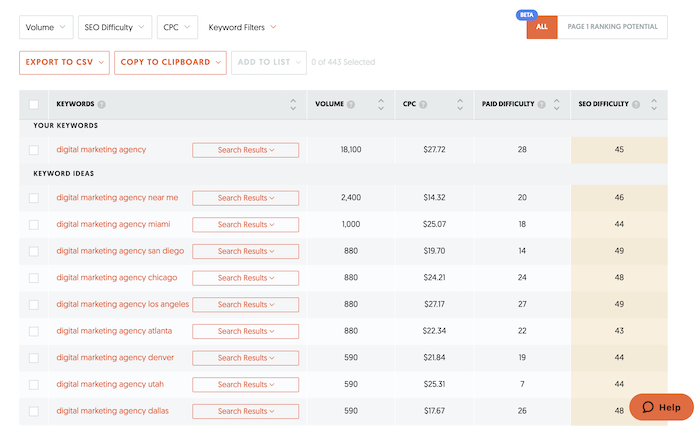
For example, say I don’t want to target any keywords with a CPC higher than $20. By clicking on the CPC filter and entering between $0 and $20, I can filter them all out.
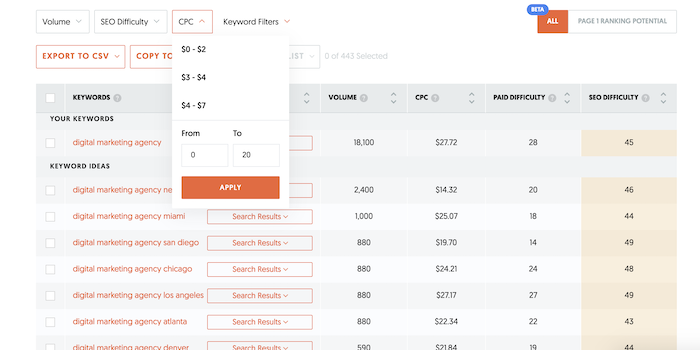
That’s just the tip of the iceberg of what you can do with a tool like Ubersuggest. For more help, see my complete Ubersuggest guide.
Automate PPC Bidding
Automated bidding will feel like a lifesaver if you’re not confident in setting bids and optimizing campaigns. Google is the best-known ad platform for automated bidding, but plenty of others like Microsoft and Facebook offer some kind of automated or smart bidding service, too.
Google offers two forms of automatic bidding: a standard automated bidding service and a smart bidding service that uses machine learning to optimize for conversions. You can target five goals when using automated bidding on Google:
- Increase site visits: Google will generate as many clicks as possible.
- Increase visibility: Google will target impression share to show your ads at the top of the page.
- Maximize conversions at your CPA: Google will drive as many conversions as possible at the target Cost per Acquisition.
- Meet a target ROAS: Google will try to maximize the value of every click.
- Maximize conversion bidding: Google will try to get the most conversion value while spending all of your budget.
The benefit of automated bidding is two-fold. First, you don’t have to worry about setting the right bids and can focus instead on other parts of the campaign. Second, Google will probably do a better job of setting bids than you.
For instance, T-Mobile boosted conversions by 22 percent, decreased cost per acquisition by 27 percent, and increased conversion rate by 23 percent by switching to automated bidding on Google.
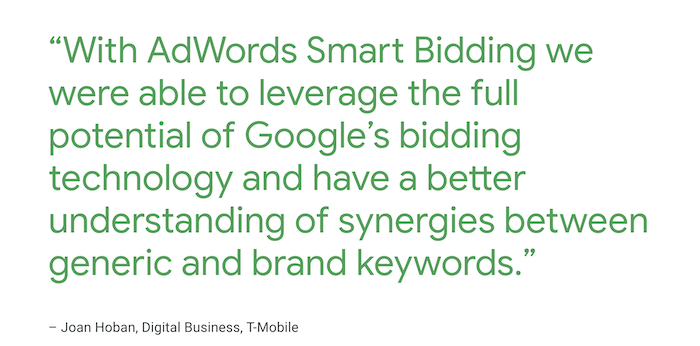
Create Hyper Personalized Ads on Facebook
Personalization should be part of every marketing strategy—and your online advertising campaign is no different. More than half of customers (60 percent) say they’re more likely to become repeat buyers after a personalized experience.
Thankfully, Facebook makes this easy with its dynamic formats and creative solution.
When you use dynamic formats and creative, you create a personalized experience for every person who sees your ad. Facebook will automatically change certain elements of your ad to suit the user’s tastes. These elements include:
- The format: Facebook will show either the carousel or collection format.
- The description: Additional information like price and delivery information may or may not be displayed.
- The media and creatives: Dynamic video can be used to create auto-generated videos using your product catalog.
- The destination: Facebook may send people to different destinations depending on where they’re most likely to convert.
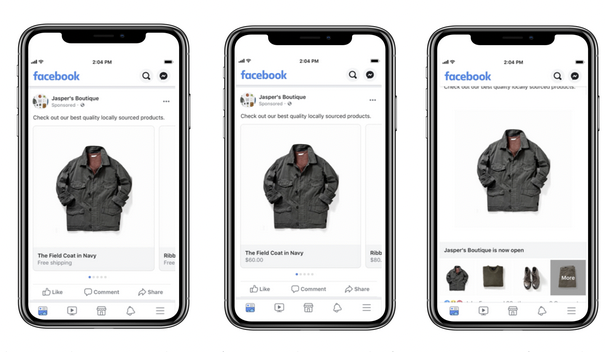
The benefits of hyper-personalized online advertising can be massive. Facebook tested the dynamic formats and creative solutions across 12 online stores and found they increased views, add-to-carts, purchases, and sales. There was also a 34 percent increase in incremental ROAS, a 10 percent improvement in lift, and a six percent decrease in cost per incremental purchase.
Use Ads to Re-Target New Customers
Most retargeting strategies focus on trying to convert consumers who have visited your site but not made a purchase. Let’s flip conventional wisdom on its head and focus on converting customers who have already bought from you.
Here’s the theory: it costs five times as much to acquire a new customer than it does to keep an existing one. You’d be better off turning one-off customers into repeat buyers rather than converting new customers.
Retargeting ads are also the perfect vehicle for these messages. According to an IAB survey, 92 percent of marketers believe retargeting ads perform the same as or better than search, 91 percent believe they perform the same as or better than email, and 92 percent believe they perform the same as or better than other display ads.
How should you re-target customers? I recommend three strategies:
- Cross-selling: Pitch them products similar or related to the customer’s first purchase.
- Upselling: Encourage them to purchase an add-on or upgrade their account.
- Subscription: Encourage them to turn their one-off purchase into a subscription.
Experiment With Under-Utilized Platforms
I’ve got bad news for you. Everyone is advertising on Facebook. Most of your competitors are also probably advertising on Google, too. Ditto for display ads. Competitors with bigger budgets will target the same audience and the same keywords. That doesn’t bode well for you.
Better ads and more optimized campaigns are two ways to stand apart from the competition, but an easier way is to advertise on platforms where your competitors don’t.
Instead of Google, run search ads on Bing or even DuckDuckGo. Read my guide on Bing for advice on how to do it.
There are plenty of other alternative ad platforms that don’t get the love they deserve. Quora is an excellent source of engaged and highly targeted users ripe for being served great ads. Motley Fool Australia used Quora to increase leads by 111 percent and lower CPAs by 47 percent, for instance.
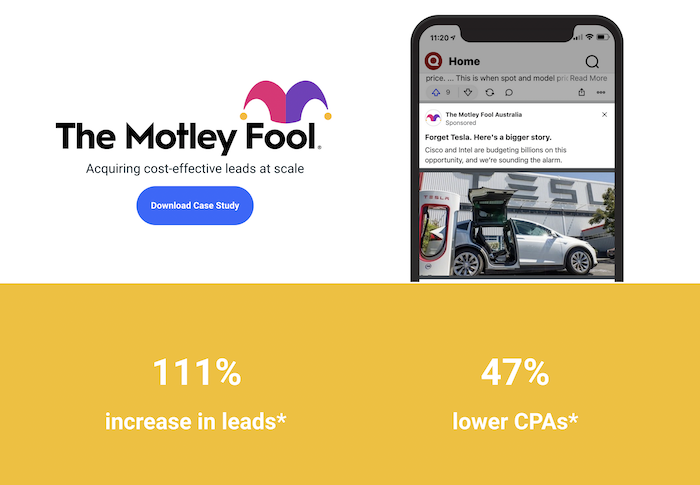
My guide to Quora is a great place to start.
Online Advertising for Business Frequently Asked Questions
What percent of my marketing budget should go to online advertising?
Your marketing budget should be between 2 percent and 5 percent of your revenue. The percentage of that budget you should dedicate to online advertising will depend on your other marketing strategies and your success with paid ads. The fewer other strategies you use and the more success you have, the more you can devote to online advertising.
What is considered online advertising?
Online advertising is any form of paid-for internet-based marketing. It includes PPC, social media ads, banner ads, display ads, video ads, and many other channels and formats.
What is the best type of online advertising?
There is no best type of online advertising. The best form of online advertising is the one that works best for your brand and audience, whether that’s search, social media, or something else entirely.
What types of businesses should do online advertising?
Any business with an online presence should consider online advertising. It’s cost-effective, highly measurable, and incredibly targeted, which makes it easy for any business to get started.
Conclusion: Online Advertising for Business
Online advertising is an incredible marketing strategy. It’s cost-effective, easy to measure, and accessible to virtually every business, big or small. I hope this article has shown you how easy it is to get started, too.
Once you’re familiar with all of the different paid marketing channels, follow my step-by-step advice to create your first online advertising campaign. Once you’re comfortable, you can start experimenting with strategies to take your online advertising campaigns to the next level.
Which channel is your favorite for online advertising?
This marketing news is not the copyright of Scott.Services – please click here to see the original source of this article. Author: Neil Patel
For more SEO, PPC, internet marketing news please check out https://news.scott.services
Why not check out our SEO, PPC marketing services at https://www.scott.services
We’re also on:
https://www.facebook.com/scottdotservices/
https://twitter.com/scottdsmith
https://plus.google.com/112865305341039147737
The post Online Advertising for Business: Creating the Perfect Plan That Gets the Customers You Want appeared first on Scott.Services Online Marketing News.
source https://news.scott.services/online-advertising-for-business-creating-the-perfect-plan-that-gets-the-customers-you-want/
No comments:
Post a Comment